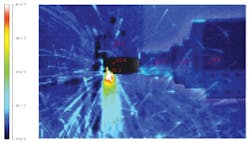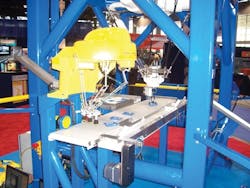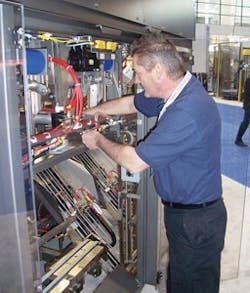Because it's hard to see the forest for the trees, sometimes an oppressive present can obscure a brighter future. This is because most machine builders focus so intently on current projects that they don't take time to think more than 10 months (or 10 minutes) into the future—so forget about looking out 10 years or more.
The future is scary—especially these days—but fear only persists until you realize that the same abilities and traditional values that helped you succeed in the past can help you do the same in the future. Imagination, perseverance and cooperation always have been crucial, and they're even more rare and useful now.
New Needs = New Capabilities
One force that drives machine builders into the future more than any other is the always growing and changing requirements of their customers—and their ongoing need to provide newer and more distinctive products for retailers and mainstream consumers.
"In the next 10 years, we're going to see machine controls going to more on-the-fly adaptability and completely automated reconfiguration," says Robert Hattin, former president of Edson Packaging Machinery Ltd. in Hamilton, Ontario. "Individual machines are getting smaller, more modular and dropping in price, but the lines they're on are mostly still on one frame that's meant to do one job and produce one thing. That's going to change."
Hattin says this is helped by miniaturized servos that run at one power level for primary motion, and run at another level for a less-frequent but heavier task. "We'll also see more integrated motion using pneumatic and hydraulic cylinders with help from intelligent servo amplifiers that use built-in encoders and position software."
To assist these mechanical improvements, Hattin says, next-generation machines will have many more wireless sensors and supporting communications that can securely send and receive real-time wireless signals from many handheld devices, including smart phones—not to mention making life simpler and easier for panel builders.
Just as machine sizes and prices are dropping, robots will become less costly, if not commodity items, and be called on to do almost all manual manufacturing functions in the coming decade, Hattin speculates. "Inexpensive robotics might even help drive some manufacturing back to North America in the future," he adds. "A six-axis SCARA robot now costs about $20,000, but prices are falling, and so it will probably cost $3,000 by 2020. As automation gets smaller, we'll see machines gain a lot more flexibility and range of motion, as well as an evolution to the same level of machine quality among regions. And all these new capabilities are going to come together in a completely integrated control system."
|
Fortunately, this unification will be necessary and come just in time to help users cope with higher energy and raw materials costs. "There's going to be even more of an energy crunch in 10 years. Costs will be through the roof by 2020," Hattin adds. "What we also need is a change in people's mindsets about machine functions. For example, if we can benchmark a machine's power consumption on a dynamic basis, then we'll really be able to make some better decisions."
Out on the Edge
Of course, there's nothing new under the sun—until there is. In mechanical engineering, it's sometimes said that no new basic physical movements have been invented in the past 150 years. The only new operations are just refinements of existing ones. However, every tool or solution had to be new once, and so some breakthroughs do come along once in a while—and they are the ones that illuminate the future.
For example, what if frictional heat were no longer a problem in metal milling? That would improve many future applications. Well, MAG Industrial Automation Systems in Erlanger, Kentucky, recently developed and demonstrated a new cryogenically cooled machining method, which uses a through-spindle, through-tool, multi-patent-pending system that cools its cutting edge far more efficiently, enabling much higher cutting speeds, increased metal removal and/or longer tool life. The liquid-nitrogen (-321 °F) cooling system also can combine with minimum-quantity lubrication (MQL) to reduce tool friction and adhesion, enabling even higher metal removal rates or longer tool life. Ideal applications involve aggressive metal removal in the hardest materials, such as titanium, nickel-based alloys, and nodular or compacted graphite iron (CGI) (Figure 1).
"We're still in development, but we've achieved 60% speed increases in milling CGI with carbide, and up to four times using polycrystalline diamond (PCD) tooling. By adding MQL, we tripled speeds with carbide, but showed no further benefit to the fourfold increase with PCD," says Doug Watts, MAG's engineering vice president. "These tests focused on metal removal increases, while keeping tool life equal to what would be achieved with conventional coolants. Early results indicate this technology could dramatically improve the lifecycle cost model for machining in a ‘hard metal' environment by reducing the required number of machines and associated plant infrastructure, or possibly increasing tool life beyond anything thought possible today."
Cost-wise, cryogenic machining becomes even more attractive when you consider it's a non-issue environmentally, Watts adds. "There is no mist collection, filtration, wet chips, contaminated workpieces or disposal cost, and certainly less energy consumption without all the pumps, fans and drives that go into handling coolant."
The efficiency of MAG's frigid system lies in its ability to concentrate its cooling effect in the body of the cutting insert, which potentially can be applied to many machining processes in future years, Watts reports. "Cryogenic machining has never been done this efficiently before, with liquid nitrogen passed through the spindle and into the insert," he explains. "Through-tool cooling provides the most efficient heat-transfer model, and consumes the least amount of liquid nitrogen. Our development work to date has focused on milling and boring, where consumption has been about 0.04 liters per minute per cutting edge. We believe drilling and tapping should be even less."
In addition, MAG's tests of its new system found that the range of capabilities for diamond tooling can be expanded with cryogenic cooling, Watts says. For example, it can extend the heat limit in CGI by three to four times, and carbide tooling, which is more affected by abrasive wear, responds best when MQL is combined with cryogenic cooling. Also, the through-spindle cryogenic cooling system is suitable for motorized, belt-driven or geared spindles.
"We're seeking partners to participate in further development, and hope to commercialize this technology next year," Watts adds.
New Thinking and Mini Robots
Several veteran machine builders say the best way to start designing and building the machine of the future is to question and think beyond the limits of the present.
"Everything became faster and more efficient during the past 10 years, and that's just going to continue into the next 10 years," says David Hanson, vice president of business development at Accraply, a division of Barry-Wehmiller in Plymouth, Minnesota. "For instance, 10-15 years ago we used to think 200 pressure-sensitive labels per minute was high speed, but now it's just medium speed, while 600 labels per minute is the new high speed. In the future, this will happen even more, and today's high speed will again become tomorrow's medium speed. However, we have faith that we can keep improving because we were able to do it in the past."
A research area expected to bear fruit in future machines is the transition of individualized print-and-apply label machines from thermal-transfer printing devices that are limited to 60-100 labels per minute to laser printing that can run at 500-1,000 labels per minute. Similar to the push for liner-less labels, however, laser-printed labels also need special materials so coatings will attach properly. These can cost 25% more, so Accraply tries to help users gain enough added speed and flexibility to make sure that moving to laser printing will be worthwhile. "Right now, we can laser print 200 barcodes per minute, while regular printers can run at 600-1,000 labels per minute," Hanson says. "In the future, we're obviously going to need bigger and more powerful lasers."
Similarly, Schneider Packaging Equipment in Brewerton, New York, works with smaller and less costly robots for carton loading and product orientation, reports Pete Squires, vice president of the company. These include Fanuc's tiny M-1iA, which is a spider-type, almost football helmet-sized robot that can do 120 picks per minute (Figure 2), or the bigger M-3iA, which has greater reach. These robots capture images by using an infrared light to look up through the nearby conveyor belt, and then use very small, end-of-arm pneumatics for fast pick-and-place of individual items.
Figure 2: Schneider Packaging Equipment uses a spider-type, football helmet-sized robot that can do 120 picks per minute.
Source: Schneider Packaging Equipment
"Several years ago, we employed the usual servos, pneumatics and hard automation for a customer loading bags of personal care products, but we found that using three robots instead took up less space, was much more configurable, and reduced changeover from 3 hours to 10 minutes," Squires says. "This is a big part of where we're going."
Because their promise and potential advantages are so significant, robots have caused Squires and his colleagues at Schneider to reconsider many of the actions and processes performed by the machines they build. "We realized we had to do more than just replace existing motions with robots. We had to rethink and see our processes in a different light," Squires explains. "In the old way, the user's product is pushed, lifted and stacked in a linear progression of motions. However, when we took these servos out, we found that we didn't have to replace one type of pushing action with another by the robot. By applying robots, we look at eliminating a lot of existing stacking and pushing mechanisms and all the adjustments they need. Robots can do several actions at once, stack products flat or sideways or 90° and in any combination. The old linear progression is gone. This means a lot less work for the mechanics, but it also means we have to do more of our thinking in software."
Schneider independently pushed much of its pioneering use of robots, Squires adds, and its end users were very accepting of its initial efforts. "Now, our customers have seen how reliable robots can be, and many demand more robots on their machines in place of more traditional technologies," he adds.
Modular Machines, Recombined Lines
As machines become more flexible, capable and modular in future years, they also will be integrated into increasingly flexible and integrated production lines.
"Now, and even more in the future, we're not just talking about how to make individual machines more efficient, but how to make all the equipment on whole production lines more compatible and able to automatically adjust to new recipes and products," says Kip Boie, sales and marketing vice president for Thiele Technologies in Minneapolis. "Our customers demand this, so we push ourselves and our suppliers." Thiele is a Barry-Wehmiller division that builds bagging and packaging machines.
Figure 3: Thiele Technologies engineer Steve Hartmann adjusts an UltraStar PBOM bagger's barcode reader, so the bags can tell the machine how to readjust their conveyors, clamps and spouts to preset specifications, which can shorten changeovers from 15 minutes to about 1 minute.
Source: Thiele Technologies
Thiele's UltraStar pinch-bottom, open-mouth (PBOM) bagging machines have been filling 15-120 lb bags for several years, but now they use barcodes on the stacks of bags to trigger automatic readjustments of all the conveyors, clamps and spouts on its integrated line to quickly change over to different sized bags and product weights (Figure 3). "Changeover used to take 10-15 minutes, but now, once the barcode is set up and the machine can go to the same specs every time, changeover takes about one minute, and our scales and palletizers on the line can do the same," Boie says. "Our users now do 10 size changes per day."
Even with these advances, the two main drivers for the next 10 years will be speed and accuracy, Boie adds. "Machine controls are evolving to be more like distributed control systems (DCSs) in the processing industries. We already let our users take output data from the I/O points and PLCs in our baggers. They can more easily check how much raw product they have in their silos, which gives the operations guys a better indication of what's coming down the pike. Once they have more information on bagging rates and changeovers in their DCS, they can do better scheduling, waste less time and improve maintenance."
About the Author
Jim Montague
Executive Editor, Control
Jim Montague is executive editor of Control. He can be contacted at [email protected].

Leaders relevant to this article:




